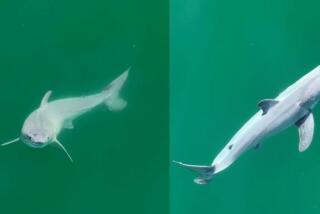Fossil shows an ancient reptile in the act of being born
Scientists have discovered the fossil remains of an ancient marine reptile in the act of being born.
As you can see in the image above, the little icthyosaur was just starting to swim headfirst out of its mother’s body at the time of its death.
Two other icthyosaur embryos, whose bones are rendered in orange and yellow in the graphic above, were still awaiting their own birth experience.
The rare fossil was discovered in what was once an inland sea that split China in two. Today, the site lies 150 miles east of Shanghai near the city of Chaohu in the Anhui province. Scientists believe the embryos and their mother were buried in a landslide.
“It must have been pretty close to where they lived because their skeletons were perfectly preserved,” said Ryosuke Motani, a paleobiologist at the University of California at Davis.
Motani and his colleagues from Peking University and the Anhui Geological Museum have been working at the site for three years. In that time they have uncovered 80 new icthyosaur skeletons that date back to the early Triassic period, roughly 248 million years ago.
Icthyosaurs, technically called ichthyopterygians, were a group of reptiles that lived at the time of the dinosaurs. They looked a bit like dolphins with a torpedo shaped body and a long, thin snout, and like dolphins, they needed to swim to the surface to breathe. Adults were just under three feet long, and they probably ate worms and other small animals living in the sea.
It is not uncommon for reptiles and fish to give birth to live young, but while most land animals give birth head first, most air-breathing marine animals like dolphins and whales give birth tail first.
“This delays the exposure of the head for the last minute, which is ideal for a water birth,” Motani said. Unlike a fish, a newly born icthyosaur or a dolphin would need to swim to the surface in order to take its first breath.
However, in the early icthyosaur fossil shown above, the embryo icthyosaur is clearly coming out of its mother head first.
In a new paper published in the journal PLOS One, Motani argues that the headfirst birth of this primitive icthyosaur fossil suggests that giving birth to live young first developed on land, and then continued to evolve in the water.
“Icthyosaurs from a much later time period were out coming out like dolphins, tail first,” he said. “But this is the most primitive kind of icthyosaur, and the headfirst birth suggests to me that its ancestors clearly lived on land.”
Motani added that more findings from the Chaohu site will be coming soon.
“There are some very interesting animals there that we didn’t know before,” he said.
If you love to learn, follow me on Twitter for more like this.







